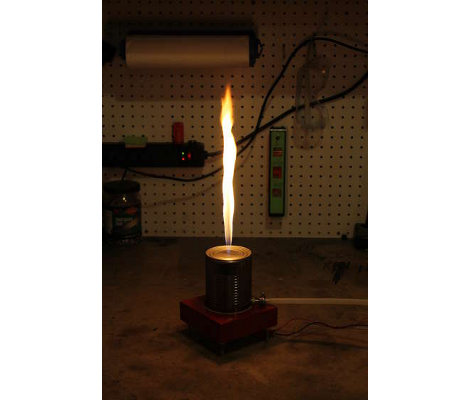
Here’s a fiery project which [Patrick] calls his Pyro Jam Can. It’s the simplest Rubens’ Tube build that we can think of. For the uninformed, a Rubens’ tube uses flammable gas to reveal wave forms passing through the supply vessel. In the past we’ve seen projects with multiple columns, which very clearly show a standing wave. But this version lacks the resolution for that, so the wave is seen as a modulated flame height.
You can see the propane feed tube coming into the can from the right. This keeps the gas flowing steadily, but a diaphram on the bottom of the can made of a latex balloon allows for modulations in flame height by pushing the gas through the aperture a bit faster than it is flowing. A speaker in the base bounces sound waves off of the diaphragm for the effect seen in the video clip after the break.
We wonder if the can will ever heat up enough to melt the balloon on the other end?
[youtube=http://www.youtube.com/watch?v=zGKzmi-NL-A&w=470]















Wonder if it could be done as with the aperature, designed with a small lip to create Gas rings(smoke rings sorta)
Awesome! Thanks for posting. As for the question regarding the can heating up and melting the balloon its hasnt been a problem so far. Matter of fact ive been able to pick the can up after 30 minutes of continuous play with no ill effects. However, i would advise builders to always double check before grabbing it. :-) Thanks again for the post.
And here I thought a Rubens’ Tube was some sort of puzzle with colored squares that twisted around to solve…
qhartman: rubik != ruben
You don’t say? huh…
My ruben’s tube http://www.youtube.com/watch?v=J9mgLcZv1Do eventually failed when it got hot enough that the foam surround on the speaker’s cone melted. Mine had no diaphram; the speaker was sized to the tube. It was in continuous operation for 5 or 6 hours though, so it wasn’t exactly surprising when it happened. This design; however, keeps the meltable bits much farther away.
The best way to avoid the heat problem would probably be just to build your own speaker cone and surround out of metal and silicone.
Answer to the question you did not ask: Paper surround, cloth surround, rubber surround.
Disadvantages:
Drivers with paper surrounds tend to not have very high excursion, and may simply be unable to move enough air to make things work.
Drivers with cloth surrounds also tend to have low excursion limits, but they’re available in any imaginable size and are often used for pro audio, and therefore the adhesives used may be more tolerant of heat than some other things.
Rubber. Who knows what sort of rubber it is, as various “rubber” compounds can be mixed fairly liberally in loudspeaker production. It may even have a lower melting point than foam, but perhaps its increased thermal mass will make up for it.
I like your build. It makes me want a fireplace of my own.
Use a set of these as a frequency visualiser!!
I’ve done a similar demonstration before, but without the speaker. When the gas gets low, and the air/fuel mix is just right in the can… BOOM!
(Ok, more of a POP! but it’s still explodey.)
Any ideas on how to failsafe that, or is it just paying very close attention to the gas flow and blowing out the flame in time?
You want a “slam shut valve.”
Your local industrial plumbing supply place (not Home Depot) may be able to help you find one that’s close to being useable, but it’s likely to be expensive-ish.
For a more DIY setup with propane, just use a pressure gauge. They’re easy, and cheap. Experiment to determine a safe pressure limit, make sure you stay above that, and just keep extra propane on-hand so that you’re never tempted to run a lower pressure than you should.
Or use natural gas. :)
This would be an awesome effect for a party. Replace Tiki torches with a series of these. Stereo for left and right side of the room, or even a visual representation of a surround sound setup.
That is really cool does it work on same system as the larger versions with just moving air http://www.instructables.com/id/Rubens-Tube-1/
Very cool, though not at all new. This is the direct predecessor to the oscilloscope. It was called a manometric flame. It was used together with a clockwork device that rotated a cylinder that had several pieces of mirror on it. Watching the reflection of the flame in the mirror gave a visible trace of the vibrations hitting the diaphragm.
Another use for this, in a similar vein, is that the position of the light from the flame changes as the height changes. If you focus the light with a cylinder lens, and direct it through a slit, the amount of light coming through the slit is dependent on the height of the flame, and thus the vibration of the diaphragm. This setup was used as a light source for some of the early mechanically scanned televisions. The light would be directed against a screw-mirror scanner, and the manometric flame connected to the speaker of a radio, to receive some of the early TV broadcasts.